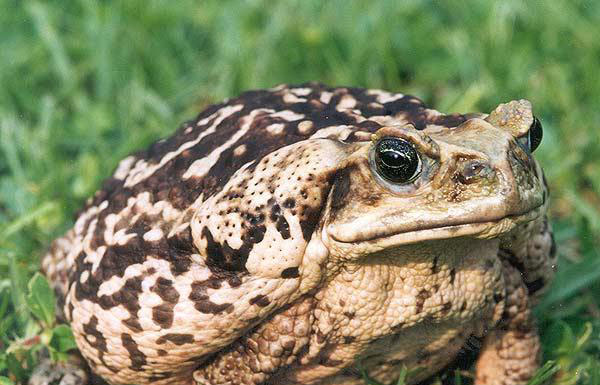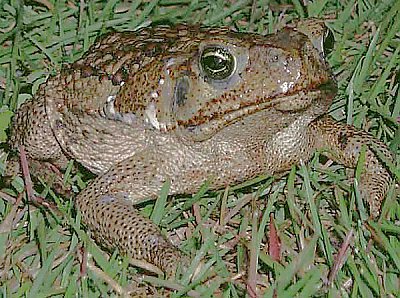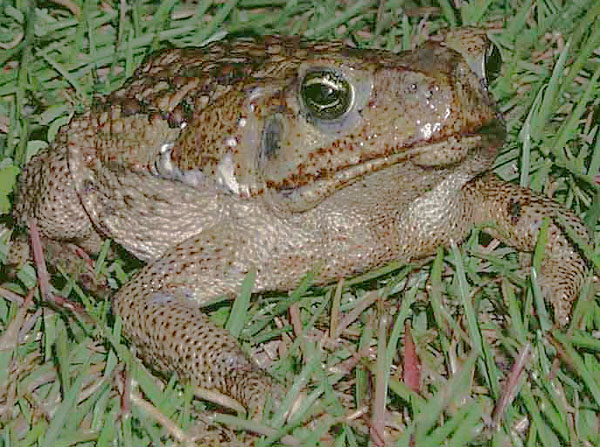What do cane toads eat?
We acknowledge the First Peoples – the Traditional Owners of the lands where we live and work, and we recognise their continuing connection to land, water and community. We pay respect to Elders – past, present and emerging – and acknowledge the important role Aboriginal Peoples and Torres Strait Islanders continue to play within the Queensland Museum Community.
- Queensland
Museum Network - Queensland
Museum - The Workshops
Rail Museum - Cobb+Co
Museum - Museum of Tropical Queensland
- Queensland Museum Network
- The Workshops Rail Museum
- Cobb+Co Museum
- Museum of Tropical Queensland
Mobile section navigation:
- Corner of Grey and Melbourne Streets, South Bank, South Brisbane
- 9:30am to 5:00pm | Public Holiday Opening Hours
Queensland Museum Network is continuing its reconciliation journey by developing an Innovate Reconciliation Action Plan. We acknowledge the Traditional Owners of Country throughout Australia and recognise their continuing connection to land, water and community. We pay respect to Aboriginal and Torres Strait Islander culture, and Elders past and present.
Animal Database
Also known as the giant or marine toad, cane toads have the dubious distinction of being on the Global Invasive Species Database of “The 100 World’s Worse Invasive Species”. Their potent poison is contained in glands in the skin and in the immense parotid glands on each shoulder. These toads are poisonous in all stages of their lives—as eggs, tadpoles, toadlets, and adults. The secretions of cane toads are highly toxic and can sicken or kill animals that bite or feed on them, including cats, dogs, birds, and snakes.

© B. Waller. Used under GFDL v1.2


Juvenile cane toad. Photo taken in Florida’s Everglades. Courtesy of USGS
SPECIES IN DETAIL
Natural: Amazon Basin in South America through Central America to the lower Rio Grande Valley of Texas. Introduced: Florida, Caribbean Islands, Hawaii, Guam, Philippines, Guam, western Pacific Islands, Papua New Guinea, and Australia.
In their natural environments these toads live in sand dunes and coastal grasslands to the margins of rain forests and mangroves. In environments into which they have been introduced, they also may inhabit urban and agricultural areas.
Cane toads are large squat amphibians. They have a bony head and bony ridges over the eyes that meet above the nose. The hind feet are webbed between the toes but the front feet are not webbed. Their most distinctive feature is their parotid glands, a large swelling on each shoulder behind the “ears” and extending down the sides that contain toxin. Their body is usually covered with warts that are tipped with small spines that also discharge toxin. Males are “wartier” than females and some females do not have any warts. Young cane toads lack conspicuous parotid glands.
The coloration of adults varies. Usually brown or gray-brown, they also can be olive or reddish-brown. They may have cream colored spots scattered across their backs, sides, and legs. The undersides are creamy-yellow, sometimes flecked with black. Tadpoles are shiny black on top with silvery-white, black spotted bellies and spots of white across the back, sides, and legs.
Females are about 10-18 cm (4-7 in) and weigh up to 1.5 kg (3.3 lb). Males are smaller.
Cane toads eat almost anything they can swallow, limited only by the size of their mouths. Most of their diet consists of insects—beetles, honey bees, ants, winged termites, and crickets—but they also occasionally eat marine snails, native frogs, small toads, snakes, and small mammals such as cats and dogs. Voracious omnivores, they have adapted to eating carrion, processed cat and dog food, and household garbage scraps.
Tadpoles eat algae and other aquatic plants. They pull off the algae with five rows of peg-like teeth. They also filter organic material from the water.
Reproduction
In most geographic areas these toads reach sexual maturity at 18-24 months. In Australia it may occur as early as 12 months. Breeding usually is seasonal from early spring to autumn starting after the season’s first rainfall or when the water temperature reaches 25 o C (77 o F). Males develop dark lumps called nuptial pads on the first two ‘fingers’ of their front limbs ; these help them grasp and hang onto a female toad. Ready to breed, the males migrate to the water’s edge of still or slow-moving breeding ponds that can be fresh or brackish, with salinity as high as 15 percent. There the males call females with a low-pitched, rattling trill that has been compared to the sound of a telephone dial or a distant tractor’s exhaust.
A male grabs a female under her ‘armpits’ and they swim together until the female touches a submerged object or a water plant. She then releases a transparent gelatinous string as long as 2.1-3 m (7-10 ft) that contains a double row of dark eggs. The string may contain 8,000-35,000 eggs. Fertilization is external. The male ejects his sperm over the spawn. Two clutches may be laid. Only about 0.5 percent of the eggs survive to reach sexual maturity and reproduce.
The eggs hatch in 1-3 days, forming a school of tiny black tadpoles. In three to twenty weeks (depending on food supply availability and water temperature of the habitat), the tadpoles metaphormose into 1-1.5 cm (0.39-0.59 in) toadlets that leave the water and congregate in large numbers.
Behavior
These toads respond to threats by turning sideways so that the parotid glands are directed toward the attacker. The toxin, bufotoxin, usually oozes out of the glands, but it can be squirted in a spray for a short distance. The toxin also is released when pressure is applied to the glands such as results from handling a toad or an animal such as a dog or cat taking it in its mouth. The milky-white toxin is absorbed through the victim’s eyes, mouth, and nose. In humans it can cause intense pain, temporary blindness, and inflammation.
Cane toads are nocturnal during the warm months of the year. In cold or dry weather they shelter in moist crevices and depressions that they excavate under logs.
Adaptation
Cane toads can lose up to 50% of their body weight through dehydration without being affected detrimentally. They replace their body fluids when water is available. They can survive in temperatures from 5 o C to 40 o C (41 o F to 104 o F)
In the wild cane toads have a life span of at least 5 years.
Conservation
Cane toads were introduced into Australia from Hawaii as a way to control sugar cane beetles whose larvae eat the roots of sugar cane, destroying the plants or stunting the growth. Unfortunately, the toads had no impact on the beetles. Cane toads live on the ground and the beetles, which live higher up on the plant, are rarely on the ground. The toads could not jump high enough to reach the beetles nor were they present when the grubs laid on the ground hatched. However, because of their breeding habits, the cane toads multiplied at a high rate and today have caused the decline of native frogs, toads, and other animals by competing successfully for food and breeding places. The Australian government spends a great deal of money annually in efforts to eradicate the toads, which have few predators. In geographic areas where the toads are native, they are not a problem because of the presence of natural predators.
Some birds and rodents have found a way to eat cane toads without being exposed to the toxin. After killing a toad, they turn it on its back, pull away the toad’s soft belly skin, and eat its internal, toxin-free organs, leaving the skin and parotid glands behind. Some native rats have learned to eat only the legs of cane toads.
A substance modified from bufotoxin is used in Japan as a hair-restorer. It is also used in oriental medicine.
Cane Toads
The audio, illustrations, photos, and videos are credited beneath the media asset, except for promotional images, which generally link to another page that contains the media credit. The Rights Holder for media is the person or group credited.
Producers
other
Last Updated
User Permissions
For information on user permissions, please read our Terms of Service. If you have questions about licensing content on this page, please contact [email protected] for more information and to obtain a license. If you have questions about how to cite anything on our website in your project or classroom presentation, please contact your teacher. She or he will best know the preferred format. When you reach out to him or her, you will need the page title, URL, and the date you accessed the resource.
Media
If a media asset is downloadable, a download button appears in the corner of the media viewer. If no button appears, you cannot download or save the media.
Text
Text on this page is printable and can be used according to our Terms of Service.
Interactives
Any interactives on this page can only be played while you are visiting our website. You cannot download interactives.
Cane Toad
In its native range—from the southern United States to northern South America—the cane toad is, well, just a big, ordinary toad.
The cane toad hatches from an egg laid in water, begins its life as a tadpole, and eats pesky insects. Cane toads are active at night.
Cane toads have poison that can kill animals that try eating them. Predators in the toad’s original range—including caimans, certain snakes, eels, and fishes—find cane toads tasty. Some are immune to their venom; others avoid the most venomous parts and can tolerate the venom they do eat.
In late March, the males begin calling their mates. Once a male attracts a female, they mate as the female lays her eggs. She lays from 4,000 to 36,000 eggs at a time in the water of a stream or pond. Tadpoles hatch from the eggs within about three days. As tadpoles, cane toads eat algae and other plants that grow in water. Cane toad tadpoles metamorphose, or change, into fully formed frogs in 12 to 60 days.
More Information
Can I remove cane toads from my property?
Yes. Cane toads are not protected in Florida except by anti-cruelty law and can be removed and humanely killed on private property year-round with landowner permission. To safely remove cane toads, wear eye and skin protection, and wear latex, rubber, or nitrile gloves if handling. Captured cane toads may not be relocated and released. Homeowners that need assistance removing cane toads from their property can hire a wildlife trapper. It is also very important to make sure that you have properly identified the animal as a cane toad and not a native southern toad, which is a beneficial part of the Florida ecosystem. Adult cane toads range in size from 6-9 inches long, while southern toads only grow to 3-4 inches long. Southern toads will have well defined cranial crests which look like ridges or horns above their eyes and a small, oval shaped gland visible behind their eyes. Cane toads do not have crests above their eyes and possess a larger, triangular shaped gland behind their eye. You can learn more about how to properly identify cane toads on this video from UF: Cane Toads – How to Identify This Invasive Pest – YouTube.
This video from the University of Florida Institute of Food and Agricultural Sciences goes over some methods to humanely capture and kill cane toads.
What should I do if my pet bites or swallows a cane toad?
If your pet bites or swallows a cane toad, they can become sick and die in as little as 15 minutes without proper treatment. Cane toads release a milky toxin that can stick in a pet’s mouth. Symptoms may include frantic or disoriented behavior, brick red gums, seizures, and foaming at the mouth. If you see these symptoms, follow these steps:
- Wash toxins forward out of mouth using a hose for ten minutes being careful not to direct water down the throat.
- Wipe gums/tongue with dish towel to remove toxins.
- Get your pet to the vet!
This instructional video from the University of Florida’s Institute of Food and Agricultural Sciences outlines these steps.
What can I do to keep cane toads off my property?
Remove places where cane toads or their prey can hide or seek shelter:
- Cut your grass regularly and keep it short
- Fill in any holes around structures
- Trim the underside of shrubs
- Keep branches or riprap off the ground
- Clear away brush piles
- Remove clutter
Remove food that can attract cane toads and their prey:
- Feed pets indoors when possible
- Bring outdoor pet food and water bowls indoors at night
- Clean up any food scraps from pet bowls or outside tables and grills
What should I do if I come into contact with a cane toad?
Thoroughly wash your hands after coming into contact with a cane toad, as you would after touching any wild animal.
Always wear latex, rubber or nitrile gloves to safely handle cane toads.
What if I have a pet cane toad I can no longer care for?
Escaped or released pets remain a primary source of introduced species in Florida, and it is illegal to introduce nonnative species into the state. Pet owners who can no longer keep their exotic pets, including cane toads, can find a new home for them through the FWC’s Exotic Pet Amnesty Program . This program helps reduce the number of nonnative species being released into the wild and fosters responsible pet ownership by giving pet owners a responsible and ecologically sound alternative to releasing an exotic animal. Note: The FWC does not rehome wild-caught nonnative wildlife.
